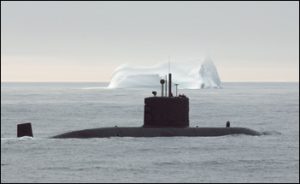
Generating unique knowledge about aging of submarine fleets has helped Canada cooperate with its allies, leveraging their knowledge in return.
Source: Canadian Neutron Beam Centre (CNBC)
Contact: cnbc@cnl.ca
The pressure hull of a submarine has to be carefully maintained because it is critical to crew safety, boat performance, and life-cycle costs to the taxpayer. The ability to to extend the life of a fleet of subs by even a few years could provide major cost savings for Canada’s navy. Extending design-life requires complex engineering analysis – such analysis relies on obtaining detailed understanding of the material state of the hull.

Victoria class submarine of the Royal Canadian Navy.
In 2007, the CNBC helped Defence Research and Development Canada (DRDC) to take advantage of a rare opportunity to generate knowledge that will be used in the life-extension analysis of Canada’s fleet of VICTORIA Class submarines. During the recent half-life refit of one of these submarines, a small section of pressure hull was replaced as part of the maintenance operations. The extracted plate happened to contain a length of original weld from its manufacture in the UK. Data on weld stresses locked through the metal thickness will be a valuable component of life extension structural assessments. Since it is impossible to obtain with other means – or without such a rare hull sample – DRDC took advantage of this opportunity to fully characterize residual stress of this type of weld using the depth-penetrating neutron beams at the CNBC.
Canada cooperates with other submarine operating allies by sharing information and pooling resources within several collaborative panels. While DRDC expects to make full use of the stress data in the future when determining long term hull fitness for service, this data has been of immediate interest to our allies who have submarines further along in their life cycles, and are addressing some residual stress issues now.
To date, the Department of National Defence has shared this data with two of our allies who requested it via the Technical Cooperation Program and other forums and it has been used as Canada’s contribution to a particular international study with the Australian Defence Science and Technology Organization. In return, Canada is privy to our allies’ experiences in other areas of common and more immediate interest, particularly in the rapidly changing realm of Non Destructive Examination. These arrangements allow Canada and its allies to get the best value for our submarine maintenance budgets.
